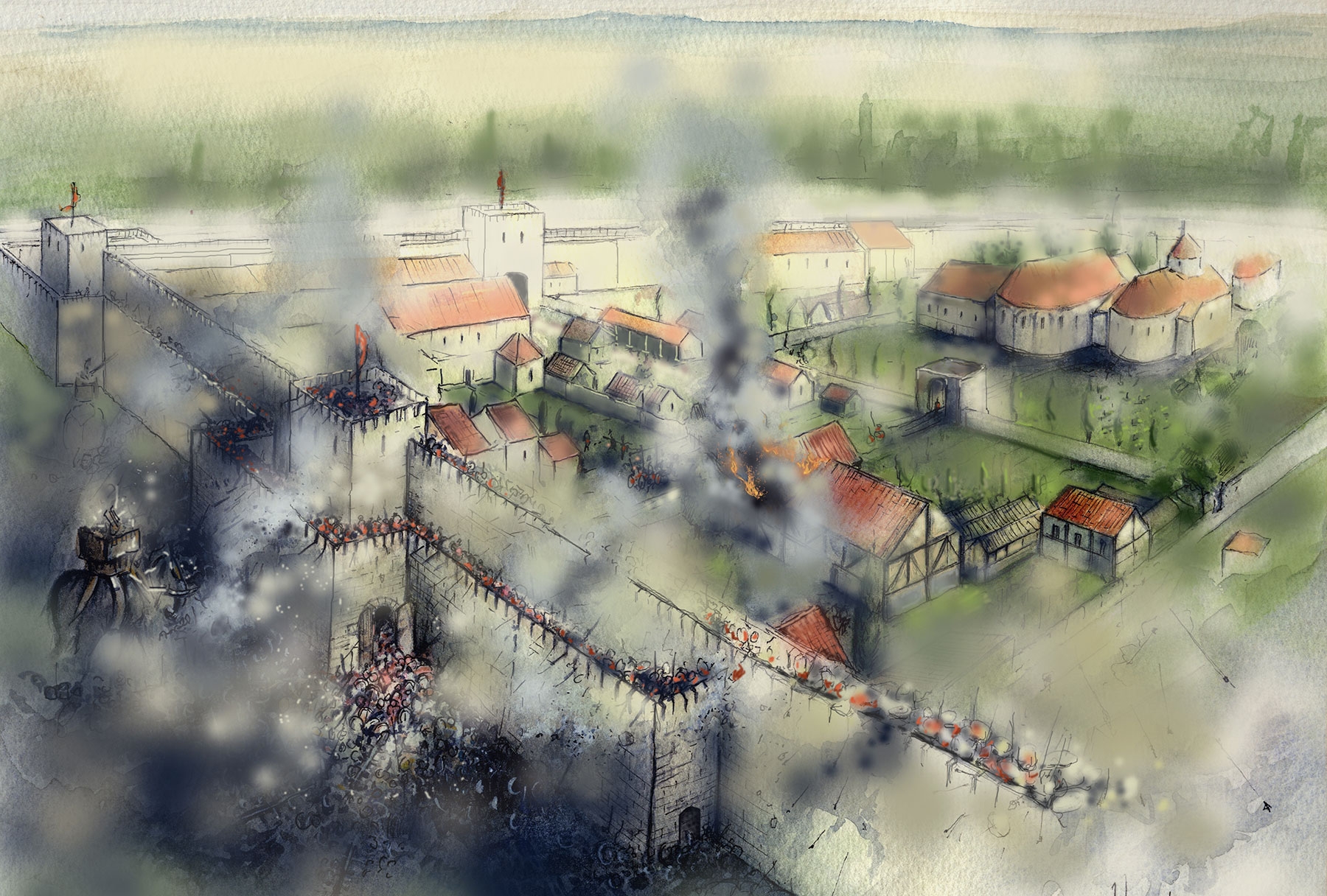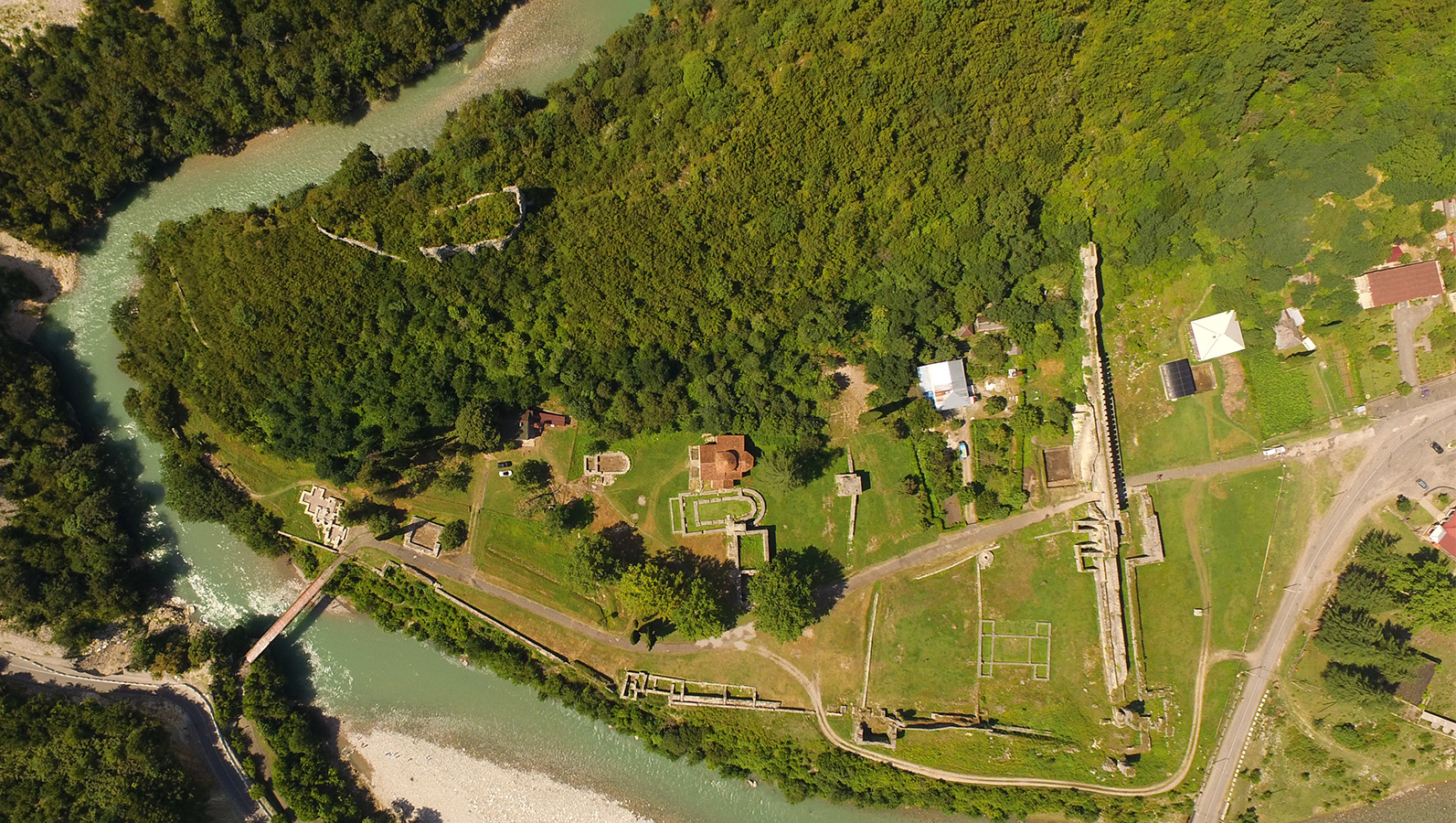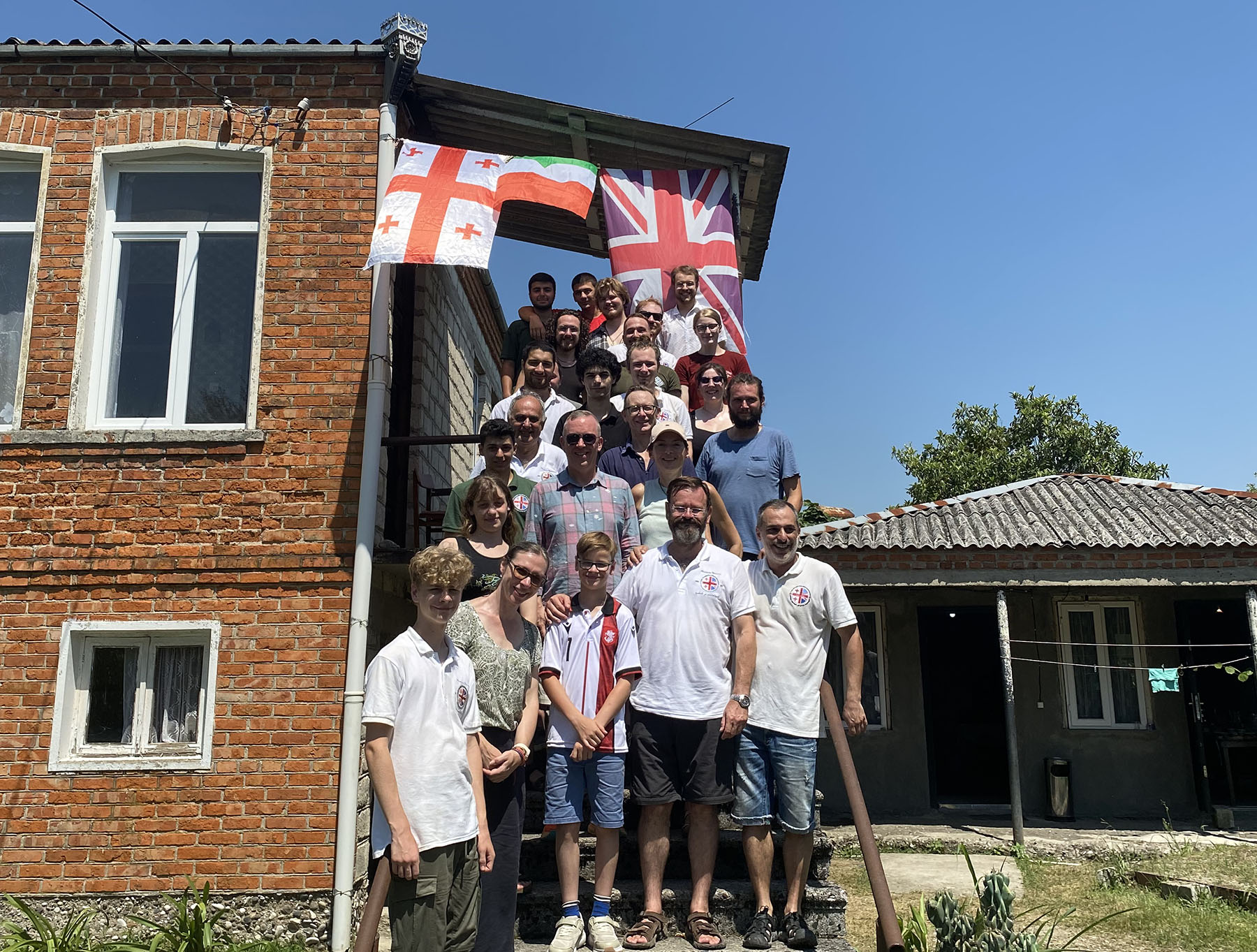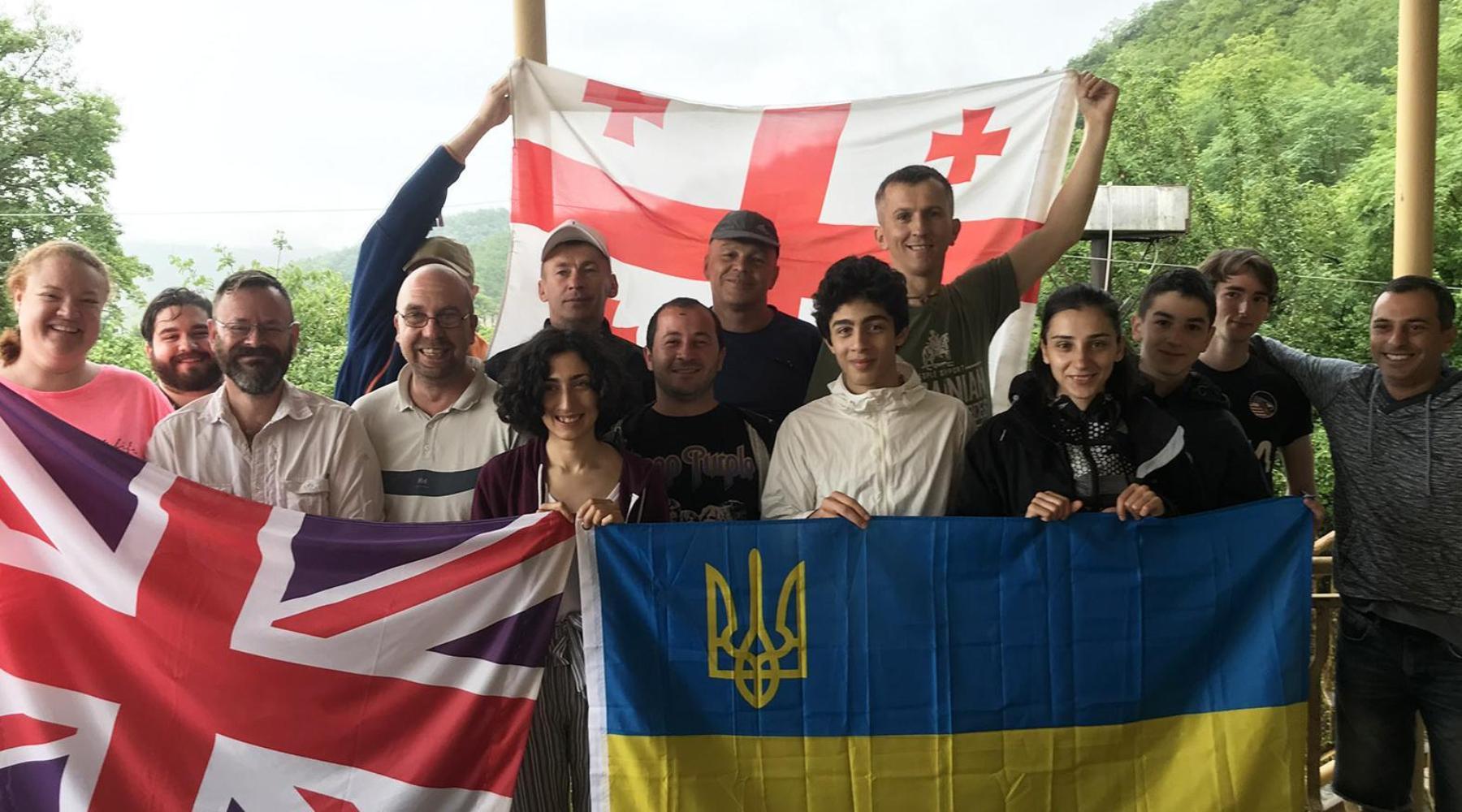Anglo-Georgian Expedition to Nokalakevi, Georgia
A collaborative project investigating an ancient fortification in the land of the Golden Fleece.

About the project
Formed in 2001 as a collaborative research project, the Anglo-Georgian Expedition has trained more than 300 Georgian, British and other archaeology students in modern excavation and recording techniques. Dr Paul Everill, Reader in Archaeology, who has been Co-Director of the expedition to Nokalakevi since 2002, is responsible for managing the excavation strategy and the training element.
Nestled by the picturesque river Tekhuri, on the northern edge of the Colchian Plain in Samegrelo, western Georgia, lie the impressive ruins of Nokalakevi. The name translates from Georgian as ‘ruins where a town was’, but this seems to pre-date the standing fortifications as the site was known to early Byzantine historians as Archaeopolis ('old city'). Georgian (Kartlian) chroniclers knew the site as Tsikhegoji, ‘the fortress of Kuji’, in reference to a semi-mythical Hellenistic-period ruler. The fortress is located 50km from the eastern Black Sea coast, and 15km from the modern town of Senaki, where it would have commanded an important crossing point of the river Tekhuri, at the junction with a valuable strategic route from the Caucasus mountains to the Colchian Plain.

Vertical drone photo of the ‘lower town’ of Nokalakevi, enclosed within a loop of the River Tekhuri (© National Agency for Cultural Heritage Preservation of Georgia 2016)
The early Byzantine defensive fortifications of Nokalakevi-Archaeopolis take advantage of the site's position within a loop of the river Tekhuri, which has carved a gorge through the local limestone. The steep and rugged terrain to the north of the site made the citadel almost unassailable, and would have provided strong natural defences even before the walls were built. Excavations have revealed small-scale activity at the site in the Bronze Age, and while there is not yet evidence of a settlement in the Iron Age the local population were by then producing, and perhaps ‘sacrificing’, ceramic double-headed zoomorphic figurines. A significant and flourishing settlement was certainly present by the 6th century BC, and appears to have continued for several centuries. This includes the Hellenistic-period (4th-1st centuries BC) and may therefore represent Kuji’s fortress, if the name Tsikhegoji has a kernel of truth. Any defensive walls or earthworks of that period appear to have been eradicated during the construction of the late Roman-period fortifications, when Nokalakevi became the capital of the Kingdom of Egrisi (known as Lazika to the Romans).
The walls of Nokalakevi-Archaeopolis-Tsikhegoji were built in three phases from the 4th to the 6th century AD, culminating in the significant strengthening of fortifications during the reign of the Byzantine Emperor Justinian as he sought to secure the eastern frontier from Persian attack. The ‘Great War of Egrisi’ was fought between the Byzantian and Persian Sasanian Empires for control of west Georgia from 541-562AD. In 551, Mermeroes, a Persian commander in Lazika, led an army consisting of a large force of Persian cavalry and archers, Huns of the Sabiri nation, Dolomite javelin throwers, and eight war elephants against the three thousand Romans and Laz stationed within the city of Archaeopolis. Despite being significantly outnumbered the defenders repulsed the attack and routed the Persian army.
Investigation history
In 1833-34, Swiss philologist Frédéric Dubois de Montpéreux identified the ruins as the Archaeopolis of Byzantine historians and argued that the site was Aia, the ancient Colchian capital of the Greek myth of Jason and the Argonauts. A century later, a joint German-Georgian team carried out the first excavations. Their findings, including an impressive hoard of late 6th to early 7th-century gold solidi, confirmed Dubois de Montpéreux's identification of the site with Archaeopolis, without settling the question of Aia. Most scholars continued (and continue) to prefer the traditional identification of Aia with Kutaisi.
The political upheavals of the 1930s and the onset of war interrupted further investigation. Nevertheless interest in Georgia's history continued to grow, prompting various scholarly visits and articles about Nokalakevi from the 1930s to the 1960s. Finally in 1973 the Department of Medieval Archaeology of the S. Janashia Museum of Georgia in Tbilisi established a Nokalakevi Expedition, led by P. Zakaraia and N. Lomouri, which undertook significant and well-funded excavations and conservation work at Nokalakevi. This continued until the early 1990s, when the collapse of the Soviet Union and the civil disturbances of Georgia's early years of independence caused funding to be stopped and which inflicted serious damage to the expedition's infrastructure. Large-scale excavations were resumed in 2001 when Professor David Lomitashvili, of the S. Janashia State History Museum (now the Georgian National Museum) and Ian Colvin (a Byzantine historian attached to Cambridge University) established the Anglo-Georgian Expedition to Nokalakevi (AGEN).
Now the longest-running international collaboration in the South Caucasus, the Anglo-Georgian Expedition to Nokalakevi has added immeasurably to the understanding of the development of the site from the earliest human activity in the Bronze Age through to the medieval period. Since 2015 the project has also encompassed the investigation of a contemporary late Roman fortification near the village of Khuntsi. Excavations have revealed substantial defensive walls and towers, which may well be the remains of the ‘lost’ fortress of Onoguris held by the Persians in their campaign in Egrisi.
Long-term friendship and collaboration
In addition to archaeological goals, the expedition has become a potent example of the long-term friendship and collaboration between Georgian and British staff and students, and has attracted diplomatic interest and regular visits from a number of British Ambassadors to Georgia. In 2009 the then Ambassador to Georgia, Denis Keefe, praised the UK team for helping to strengthen international ties, following the Russian invasion the previous year, and became a regular visitor to Nokalakevi with his family. In 2020, when COVID prevented travel from the UK and impacted plans to celebrate the 20th season, Ambassador Justin McKenzie Smith joined a small Georgian team at the site to mark the occasion. In 2025, Ambassador Gareth Ward visited the expedition to celebrate the expedition’s 25th season.
 The 2025 team with Ambassador Gareth Ward (with sunglasses)
The 2025 team with Ambassador Gareth Ward (with sunglasses)
Archaeology for wellbeing: Nokalakevi and the Heritage for Heroes project
As part of its commitment to supporting British military service personnel, veterans and their families, the University of Winchester offers studentships to military veterans. The Archaeology team is at the forefront of this initiative and in 2016, we welcomed the first cohort of Heritage for Heroes students on undergraduate courses in Archaeology. In summer 2017, three veteran studentship-holders joined Dr Everill's Nokalakevi project, working alongside other students as well as Georgian veterans. In 2019 a total of 12 veterans lived and worked in Nokalakevi alongside Georgian, British and American staff and students. Find out more about the Heritage for Heroes project.
 Dr Paul Everill (third from left) with the international team including students and veterans during the summer 2019 field season.
Dr Paul Everill (third from left) with the international team including students and veterans during the summer 2019 field season.
Research team
- Head of Expedition: Dr Nikoloz Murgulia, Senior Scientist, Georgian National Museum, Tbilisi
- Co-Director: Dr Paul Everill, Reader in Archaeology/Deputy Head of the School of Humanities
- AGEN Director: Ian Colvin, Historian (South Caucasus, Roman and Sasanian Empires), Cambridge University
- Founder: Professor Davit Lomitashvili, Senior Scientist, Georgian National Museum, Tbilisi
- Head of Khuntsi Expedition: Dr Besik Lortkipanidze, Senior Scientist, Georgian National Museum, Tbilisi
Further information
For more information, visit the expedition website, follow the project on Facebook and Instagram, or read the latest publications:
- Everill, P., Murgulia, N., Doherty, S., Colvin, I., Lortkipanidze, B. and Lomitashvili, D. 2024. Schneider’s Tower: An Extraordinary Archaeological Collaboration Between the Soviet Narkompros and the Notgemeinschaft Der Deutschen Wissenschaft, Nokalakevi, Georgia 1930–31. Bulletin of the History of Archaeology 34(1): 1–23.
- Intagliata, E. and Everill, P. (eds) 2023. On the Shoulders of Prometheus: International Collaboration and the Archaeology of Georgia. Georgian Archaeological Monographs. Oxford, Archaeopress
- Everill, P., Murgulia, N., Lomitashvili, D., Colvin, I., Lortkipanidze, B. 2023. Nokalakevi–Archaeopolis: Twenty Years of Anglo-Georgian Collaboration. In Intagliata, E. and Everill, P. (eds) On the Shoulders of Prometheus: International Collaboration and the Archaeology of Georgia. Georgian Archaeological Monographs. Oxford, Archaeopress: 85-98
- Everill, P., Murgulia, N., and Lomitashvili, D. 2022. Wellbeing and brotherhood on the Colchian Plain: Engagement with multinational veterans through archaeological excavation at Nokalakevi, Georgia. In Everill, P. and Burnell, K. (eds) Archaeology, Heritage, and Wellbeing: Authentic, powerful and therapeutic engagement with the past. Routledge.
- Everill, P., Murgulia, N., Lomitashvili, D., Colvin, I., Lortkipanidze, B., Schwenninger, J-L, and Cook, G. 2021. The recent contribution of scientific techniques to the study of Nokalakevi in Samegrelo, Georgia. Anatolian Studies 71: 29-45
- Everill, P., Lomitashvili, D., Murgulia, N., Lortkipanidze, B., and Colvin, I. 2021. From Archaeopolis to Onoguris: Excavations in the heart of Lazika. In Tsetskhladze, G., Avram, A. and Hargrave, J. (eds) The Greeks and Romans in the Black Sea and the Importance of the Pontic Region for the Graeco-Roman World (7th century BC-5th century AD): 20 Years On (1997-2017): Proceedings of the Sixth International Congress on Black Sea Antiquities (Constanţa – 18-22 September 2017). Oxford, Archaeopress: 466-476
- Everill, P. 2019. Travellers’ Tales of Mingrelia and of the ancient fortress of Nokalakevi. Ancient West and East 18: 195-224 https://doi.org/10.2143/AWE.18.0.3287214
- Everill, P. et al. (2018) Bringing methodology to the fore: The Anglo-Georgian Expedition to Nokalakevi. Ancient West and East Vol. 17.
- Everill, P. et al. (2017) The lost fortress of Onoguris? Newly discovered sixth-century AD fortifications at Khuntsistsikhe, western Georgia. Antiquity Vol. 91 Issue 365.
- Everill, P. (Ed.) 2014. Nokalakevi Tsikhegoji Archaeopolis: Archaeological excavations 2001-10. Anglo-Georgian Expedition to Nokalakevi. BAR International Series 2612. Oxford, Archaeopress
- Everill et al. 2010, Nokalakevi-Archaeopolis: ten years of Anglo-Georgian collaboration. Antiquity 84 (326)
